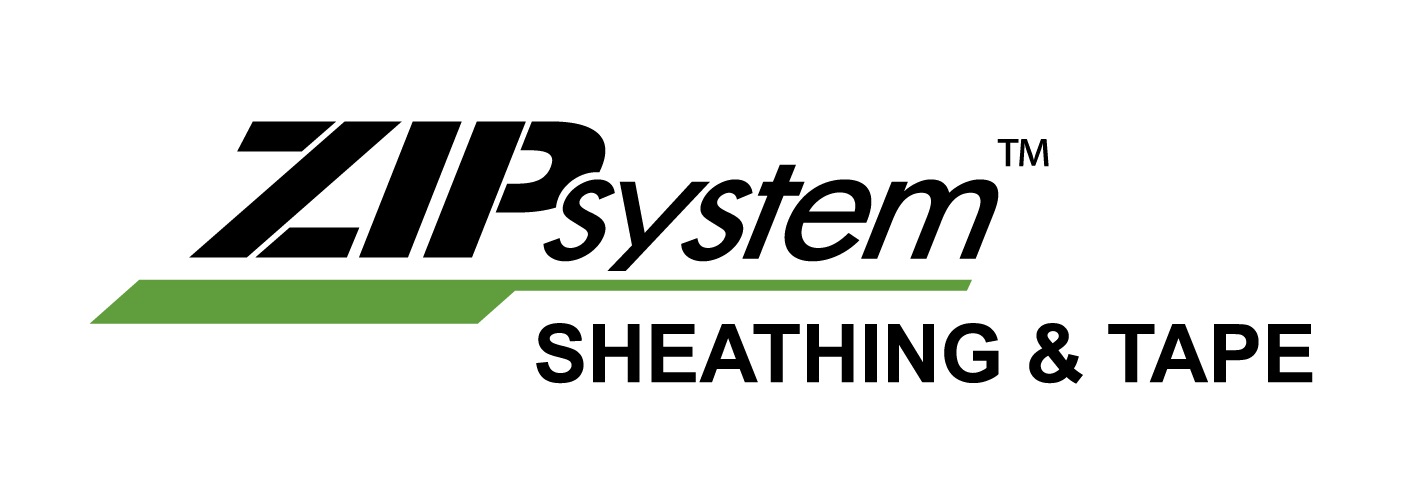This CE Center article is no longer eligible for receiving credits.
Cavity-Vented Insulated Pitched Roof
There are circumstances where a horizontal ceiling and attic space above do not meet the design needs of a building. In those cases, the assembly may be more compact, creating a pitched roof and sloped ceiling all in one, but all of the same barrier and ventilation needs must still be addressed. The common approach is to use roof framing members that are deep enough to carry the structural loads, fit the needed level of insulation in between, and still provide space for ventilation. In some climate zones, even a 2-by-12 rafter may not be enough to achieve all of that, so a deeper flat truss or other engineered member may be called into play. Regardless, the water barrier will still remain on the exterior surface of the assembly, while the air barrier and vapor retarder are along the inner face. Insulation is installed between the framing members to the level needed or desired depending on the type and corresponding R-value per inch (i.e., batts, spray foam, etc.). The depth of the insulation will be restricted by the need for a continuous ventilation space of at least 2 inches of depth that allows air to flow between the soffit and the ridge openings such that each framing space is ventilated (not every other space as some would purport). Commonly, continuous vent chutes or insulation barriers are installed along the underside of the roof sheathing to assure that ventilation space is maintained.
Top-Vented Insulated Pitched Roof
If providing enough ventilation and insulation all in one framing member depth is not readily achievable, then the alternative is to construct an additional ventilation layer on top of the framing layer. In this case, the framing cavity is filled with insulation or rigid insulation is applied over a timber frame and ceiling system. A minimum 2-inch air space is then provided as an “over-roof” to carry away any moisture that escapes up through joints in the insulation. The ventilation space also helps keep the underside of the over-roof surface cold, thus avoiding snow melting and forming ice dams. Dr. Lstiburek recommends this over-roof approach when structural insulated panels (SIPS) are used too since the panel joints can be sources of air exfiltration from within the building. While this over-roof approach is effective for ventilation, it can be more costly to construct since it involves the creation of the ventilation channel that needs to support the sheathing and roofing water barrier.
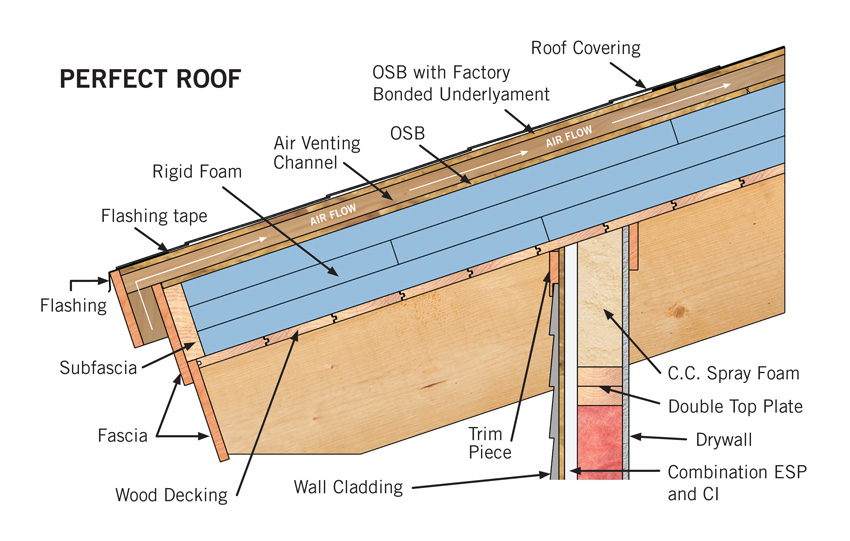
A top-vented insulated pitched roof includes rigid insulation with joints staggered and a 2-inch air channel to carry any moisture in the roof out through a ridge vent.
Unvented Insulated Pitched Roof
This assembly uses a sloped roof/ceiling assembly with insulation filling the entire depth between ceiling and roof sheathing. That can be constructed of rigid insulation that is air impermeable (i.e., serves as an air barrier) between the inner and outer surface, such as closed-cell polyurethane or poly-isocyanurate with water-, vapor-, and air-barrier capabilities inherent to the insulation. This might also be achieved by spraying air-impermeable insulation completely between roof framing for the full depth. Or manufactured SIPS may be used if they employ air-impermeable insulation. In these cases, the roof system relies on the multiple properties of the insulation and other materials to form fully continuous air, thermal, and moisture barriers. Therefore, no ventilation is called for or provided.
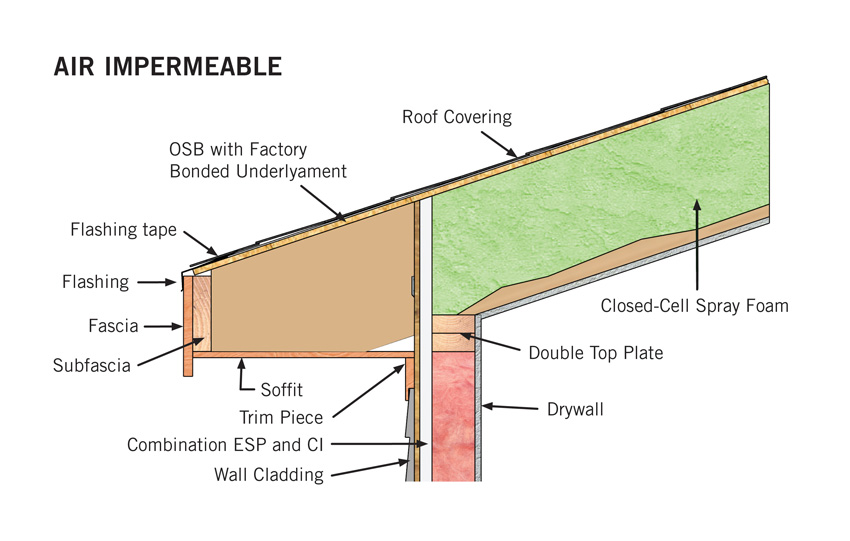
An unvented insulated sloped roof is one that commonly uses air-impermeable insulation in all or most of the space between framing members (shown as light green color in illustration), usually in the form of spray foam insulation.
Options Recognized by Code
Most wood-framed building construction follows the International Residential Code (IRC), which provides significant detail on all aspects of wood framing. In particular, Chapter 8 of the IRC specifically addresses Roof-Ceiling construction, while Section R806 is focused on Roof Ventilation. For light commercial or multifamily wood-framed construction, The International Building Code will apply. There, Chapter 12 addresses Roof Ventilation in Section 1202.2 and Table 1202.3. With all of these code references as a basis, we can review the relevant provisions as follows.
Vented Roof Assemblies
IRC Section R806.1 and IBC 1202.2.1 both require “cross ventilation for each separate space by ventilating openings protected against the entrance of rain or snow” for both “enclosed attics” and “enclosed rafter spaces formed where ceilings are applied directly to the underside of roof rafters.” This is the basis for both the vented attic and the cavity-vented insulated pitched roof described above and influences the “over-roof” also described above. Each code also prescribes minimum vent area: “The minimum net free ventilating area shall be 1⁄150 of the area of the vented space.” In each case, exceptions are listed to reduce the amount of ventilation to 1⁄300 of the vented area provided certain conditions are met that would reduce the likelihood of vapor intrusion. Either way, the codes first identify and prescribe the minimum acceptable levels of ventilation for drying a vented roof assembly. In addition, both IRC R806.3 and IBC 1202.2.1 address the requirement for a minimum 1-inch clearance between the insulation and sheathing to provide proper airflow. Note that most building scientists will recommend at least 2 inches of clearance for best performance (i.e., more than the code minimum). Finally, the codes address the need for all ventilation openings to be designed and installed to assure appropriate weather protection and prevention of intrusion by insects, rodents, etc.
High-performance wood-framed building enclosures often focus on wall designs, but there is an equal need and growing amount of attention on roof assembly designs. Matt Minchew has observed this quite heavily in his role as General Manager of ZIP System Roof and notes, “For the past 10 years, energy code cycles have focused on wall assemblies. Higher R-values, airtightness, reduction of thermal bridging, and condensation control has been emphasized in the energy code.” He goes on to point out the shift, stating, “Recent code changes have begun to influence roof design to emphasize the same assembly functionalities. Methods to achieve unvented attic assemblies are evolving and bring attention to the need for proper detailing of moisture, air, thermal, and vapor control.” In essence, he is reminding us that all of the same concerns for providing the appropriate barriers in wall assemblies are equally important as part of good roofing design in wood-framed buildings too. Therefore, in this course, we will focus on wood-framed roof assembly options, some of the building science principles that influence good roof design, and some of the emerging options recognized in the International Energy Conservation Code (IECC), International Residential Code (IRC), and International Building Code.
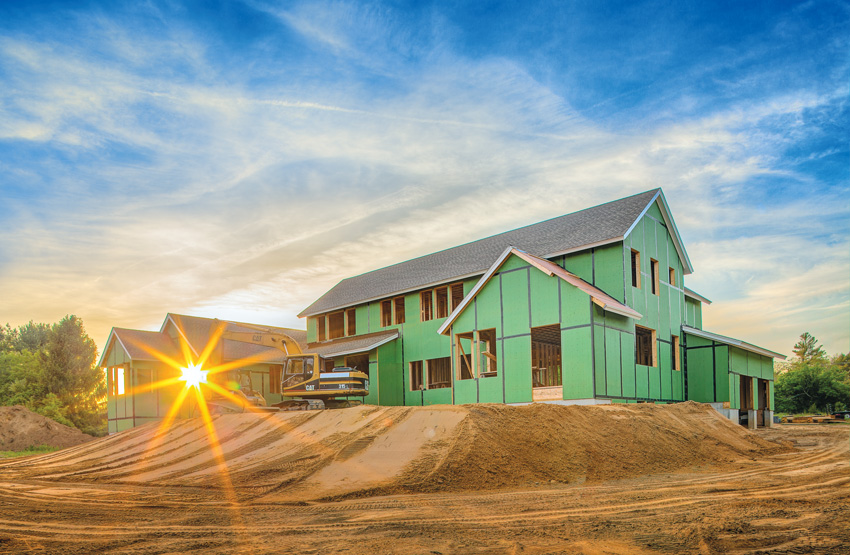
All images courtesy of Huber Engineered Woods © 2018
Wood-framed sloped roofs need to provide all of the same functions as exterior walls, if not more so, including weathering, thermal resistance, air barriers, and moisture control using vapor retarders and ventilation.
Primary Functions of a Wood-Framed Sloped Roof
Wood-framed sloped roofs have been a common means to provide shelter and protection from the weather for centuries. The methods of construction have included everything from simple “lean-to” structures to post-and-beam framing, spaced rafter framing, and most recently engineered wood trusses with engineered sheathing. Beyond simply providing structure and covering, however, wood-framed roof design has evolved in recent times in several important ways. Perhaps the most notable is the need for higher thermal performance to meet energy conservation and comfort demands. That has included not only accommodating more insulation but also providing air barriers to control unwanted air infiltration or drafts. Related to that is the control of airborne moisture or vapor that needs to be restricted to keep it out of roof construction or allow it to dissipate away when needed. Of course, water drainage is needed for bulk water too, not only in the form of precipitation but also from the melting of ice dams or other cold-weather concerns. Holistically speaking then, wood-framed roofs are no longer just a structural item but need to be seen as a complete, coordinated assembly to provide at least four barriers—one each for water, air, moisture, and thermal control.
Barriers versus Ventilation
The difference between a successful roof system and one that falls short is the ability to create an unbroken line of defense in all of these four barriers. Achieving that objective requires more than just a note on the construction drawings calling for these barriers to be “continuous.” It requires proper design and detailing of the roof assembly conditions, which means the person doing that detailing needs an understanding of the fundamental building science and physics that contribute to a successful design. Building codes take advantage of some of that building science and establish minimum requirements for typical roof construction systems. However, the codes don’t do the design of a particular roof system—that’s the role of the design professional.
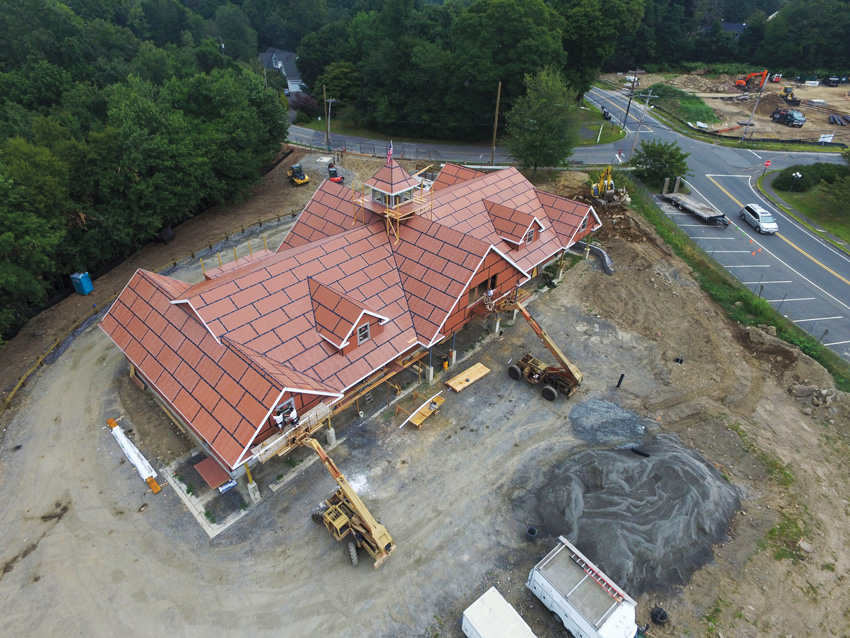
Successful roofing systems need to address barriers and proper ventilation in a truly continuous manner.
Another recognized key to a successful roof system is having a backup means to prevent damage in the event water or moisture does breach the barriers. Unanticipated water can cause wood to rot or otherwise deteriorate over time, render some insulation relatively useless if it becomes even partly saturated, and drain into the rest of the building causing additional damage. Commonly, the backup means to prevent this is done by providing ventilation (i.e., as in attic spaces) or using assemblies that create a drainage plane for water to drain away harmlessly. Once again, the building codes have some specific requirements to be sure this is addressed in the interest of protecting the integrity of the structure and the rest of the building, but they do not purport to design the means to achieve it in any particular project.
In the quest for a source of reliable information and assistance on better building assembly design, it is not uncommon for architects to turn to independent consultants or specialists. One such independent source is Peter Yost who is vice president of building performance for Building Green in Brattleboro, Vermont, and technical director for Taunton Press’s GreenBuildingAdvisor.com. Yost has more than 30 years of experience in building, researching, teaching, writing, and consulting on high-performance buildings. His work includes both academic and vocational instruction, field research on building products, building investigations, construction document review, and technical research and writing. A LEED AP, he is a past co-chair of the USGBC’s LEED for Homes program and a certified instructor/course author for the NAHB Advanced Green Building: Building Science certificate program. Yost is also a lecturer for Yale’s graduate program in Forestry & Environmental Studies, an instructor for the Boston Architectural College’s Sustainable Design Certificate program, and research associate with the University of Massachusetts Department of Building Construction and Technology program.
Prioritizing Barriers
In light of his past experience, it is easy to see why Yost has published information about the four barriers of a wood-framed roof assembly and the importance of keeping them continuous. In particular, he has taken the approach to prioritize these barriers in the following order1:
- A continuous bulk-water-control layer
- A continuous air-control layer
- Dedicated, directional drying potential (vapor control and ventilation)
- A continuous thermal-control layer
He emphasizes the fact that problems arise when we do not honor this prioritization in roof and wall assemblies. For example, a design focus on the continuity of bulk-water and air-control layers means the assembly is less likely to have water or air leakage. That in turn means the need for drying is reduced and ventilation is relied on less. Drainage that uses conventional weather-lapped roofing including proper underlayment, flashings, etc. is a proven means to address the number-one threat of bulk water. Moving that water quickly and completely off of the roof is the best line of defense. Similarly, preventing air infiltration where it is not wanted means that vapor in that air is kept out too. That prevents condensation from occurring when the moisture-laden air cools on a material or surface and turns to water droplets.
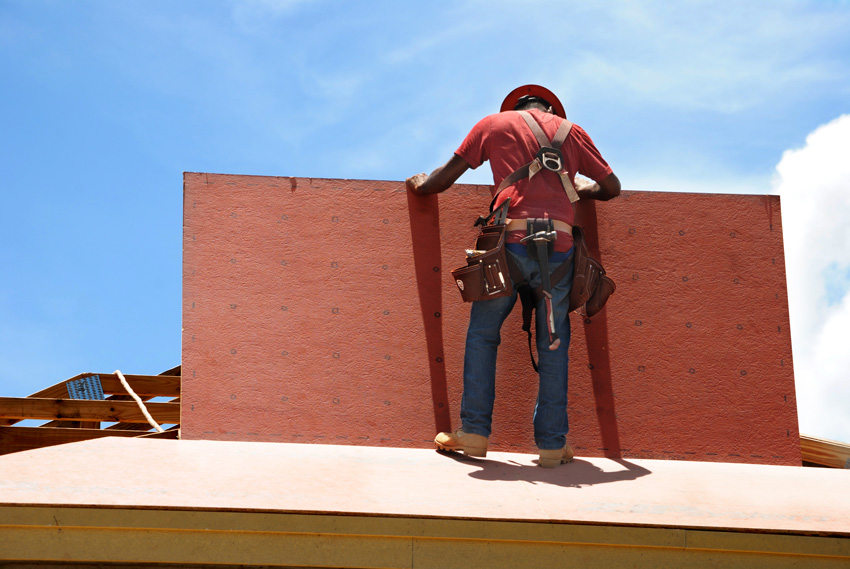
Providing an air barrier as part of the roofing sheathing is one way to assure continuity and
effective performance of the roof.
Since air barriers are second on the list, it is important to have a source to define whether something really qualifies as an air barrier or not. One of the leading sources for researching and testing materials and assemblies for air permeance is the Air Barrier Association of America (ABAA), which, according to the website, is a “national, not-for-profit trade association that consists of a wide cross section of stakeholders in the building enclosure industry. Their membership includes manufacturers, architects, engineers, trade contractors, researchers, testing and audit agencies, consultants, and building owners.” Using data and information from this organization can help identify both individual materials and assembled systems that will qualify to properly restrict airflow through a roof or wall. They can also provide information on critical areas to address in those assemblies through their education and certification programs for professionals. In some cases, materials can qualify as an air barrier and also as another type of barrier such as water or moisture, or insulation may, in some cases, qualify as an air barrier, all depending on the proper testing and reporting of results.
Different Types of Ventilation
Of course, if water is penetrating an assembly somewhere, either from bulk water or from airborne water vapor, no amount of roof surface drainage will solve the problem—it will only keep it from getting worse. Hence, the means of fully drying a roof assembly if it does get wet must still be properly addressed. There are two common options to provide that ventilation. The best and preferred means is to provide convective drying through a means that sets up an actual airflow through the assembly. Continuous soffit vents that are sized and balanced with a continuous ridge vent are the most common way to achieve this convective ventilation. In this case, air that is warmed by the sun or other means in a roof assembly is allowed to escape out through the ridge vent. That movement then brings in replacement air that is pulled in through the soffit vents, thus creating a full convective current as the means of ventilation.
The second means of drying a roof assembly or materials is simply through diffusive drying, which is the natural process of materials slowly giving up their moisture by releasing it to the air as water vapor. That released moisture can then either move out to the exterior of the building or move to the interior. The speed and direction of the vapor diffusion can be determined by looking at the permeability of the materials used in a roof assembly. Building scientists, like Yost and others, refer to this as creating a “vapor profile” which allows them to help determine how well a particular assembly will dry, and in what direction (to the interior or exterior) if it does get wet.
Clearly, designing the roof assembly to address water- and air-barrier continuity is the first and best approach. Then, proper ventilation needs to be provided so water or vapor has a ventilated path to escape and avoid causing problems. Of course, if an air leakage problem exists, adding ventilation isn’t the way to solve it—the source of unwanted air leakage needs to be sealed.
Standard Design and Construction Options
Plenty of wood-framed roofs have been constructed over the past 40–50 years or so with different levels of understanding of the need to provide the four barriers and proper ventilation. Some assembly designs have come about through trial and error, and some have been found to work quite well under defined circumstances. In particular, some have tried to solve specific design problems, such as pitched, non-attic types of assemblies. One of the well-known design professionals who has spent a considerable amount of his time and effort looking at the barrier and ventilation/drying aspects of different types of roof construction assemblies is Joe Lstiburek, Ph.D., PE, ASHRAE Fellow, who is the founding principal of Building Science Corporation headquartered in Westford, Massachusetts. According to the firm’s website, “Dr. Lstiburek’s work has been focused on advancing the building industry with a lasting impact on building codes and practices throughout the world, particularly in the areas of air barriers, vapor barriers, and vented and unvented roof assemblies. Of note, his work through the Department of Energy’s Building America program led to significant research into the wetting and drying of walls and ultimately to a major code change relaxing the requirement for vapor barriers in the International Residential Code.” He and his firm have addressed all types of roof construction assemblies through research, testing, consulting, and forensic exploration and make a great deal of their findings available for free at www.buildingscience.com.
Among the most commonly used wood-framed roof construction approaches that Dr. Lstiburek’s firm and others have looked at are the following four.
Vented Attic
This is probably the most common type of wood-framed roof assembly being built currently. Vented attics rely either on engineered trusses or rafters with ceiling joists to form an open, unconditioned attic space. Here, the water barrier is located on the roof surface above the attic, while the air barrier is along the ceiling surface below with the vapor retarder and thermal barrier (insulation). Note that the air barrier in the walls may well be in a different location, such as on the exterior of the sheathing, so to be fully continuous, the details of air sealing need to connect these two locations. Attic ventilation above the air and thermal barrier is most commonly provided using soffit and ridge vents or other acceptable means if dictated by the roof design or type. Properly designed and constructed with attention paid to the needed levels of insulation as well as the integrity and continuity of all barriers and ventilation, this roofing system can be expected to perform very well over time in almost all climate zones.
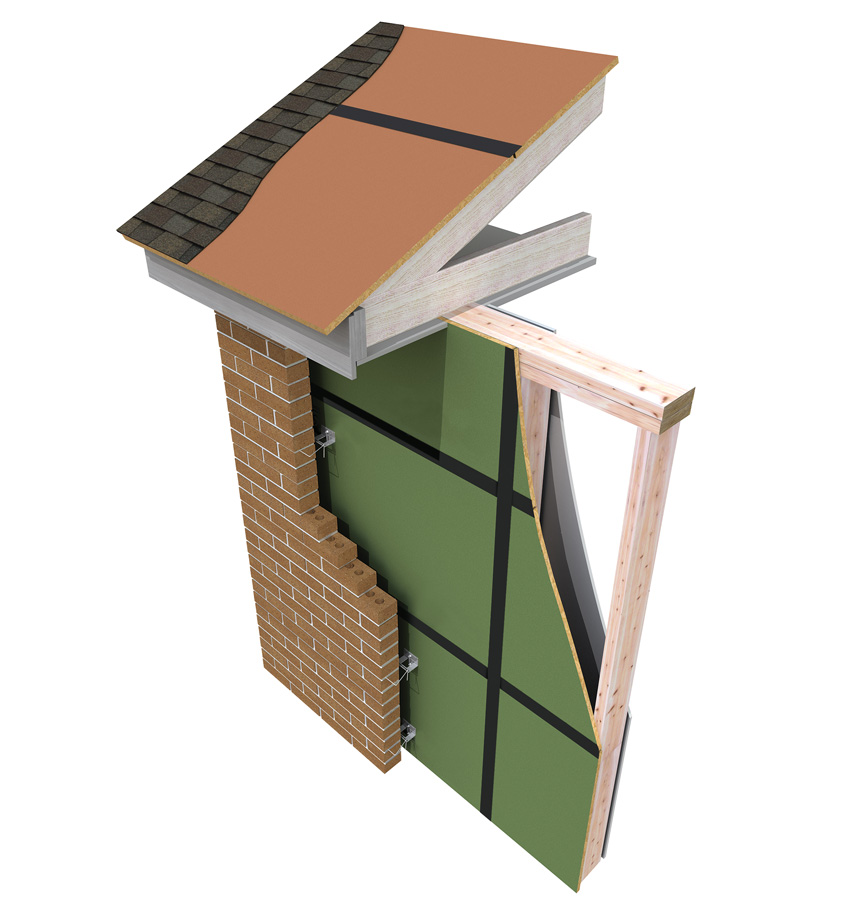
Among the most common wood-framed construction types, flat ceilings with an insulated attic above are prevalent and require proper ventilation as called for in the building codes.
Cavity-Vented Insulated Pitched Roof
There are circumstances where a horizontal ceiling and attic space above do not meet the design needs of a building. In those cases, the assembly may be more compact, creating a pitched roof and sloped ceiling all in one, but all of the same barrier and ventilation needs must still be addressed. The common approach is to use roof framing members that are deep enough to carry the structural loads, fit the needed level of insulation in between, and still provide space for ventilation. In some climate zones, even a 2-by-12 rafter may not be enough to achieve all of that, so a deeper flat truss or other engineered member may be called into play. Regardless, the water barrier will still remain on the exterior surface of the assembly, while the air barrier and vapor retarder are along the inner face. Insulation is installed between the framing members to the level needed or desired depending on the type and corresponding R-value per inch (i.e., batts, spray foam, etc.). The depth of the insulation will be restricted by the need for a continuous ventilation space of at least 2 inches of depth that allows air to flow between the soffit and the ridge openings such that each framing space is ventilated (not every other space as some would purport). Commonly, continuous vent chutes or insulation barriers are installed along the underside of the roof sheathing to assure that ventilation space is maintained.
Top-Vented Insulated Pitched Roof
If providing enough ventilation and insulation all in one framing member depth is not readily achievable, then the alternative is to construct an additional ventilation layer on top of the framing layer. In this case, the framing cavity is filled with insulation or rigid insulation is applied over a timber frame and ceiling system. A minimum 2-inch air space is then provided as an “over-roof” to carry away any moisture that escapes up through joints in the insulation. The ventilation space also helps keep the underside of the over-roof surface cold, thus avoiding snow melting and forming ice dams. Dr. Lstiburek recommends this over-roof approach when structural insulated panels (SIPS) are used too since the panel joints can be sources of air exfiltration from within the building. While this over-roof approach is effective for ventilation, it can be more costly to construct since it involves the creation of the ventilation channel that needs to support the sheathing and roofing water barrier.

A top-vented insulated pitched roof includes rigid insulation with joints staggered and a 2-inch air channel to carry any moisture in the roof out through a ridge vent.
Unvented Insulated Pitched Roof
This assembly uses a sloped roof/ceiling assembly with insulation filling the entire depth between ceiling and roof sheathing. That can be constructed of rigid insulation that is air impermeable (i.e., serves as an air barrier) between the inner and outer surface, such as closed-cell polyurethane or poly-isocyanurate with water-, vapor-, and air-barrier capabilities inherent to the insulation. This might also be achieved by spraying air-impermeable insulation completely between roof framing for the full depth. Or manufactured SIPS may be used if they employ air-impermeable insulation. In these cases, the roof system relies on the multiple properties of the insulation and other materials to form fully continuous air, thermal, and moisture barriers. Therefore, no ventilation is called for or provided.

An unvented insulated sloped roof is one that commonly uses air-impermeable insulation in all or most of the space between framing members (shown as light green color in illustration), usually in the form of spray foam insulation.
Options Recognized by Code
Most wood-framed building construction follows the International Residential Code (IRC), which provides significant detail on all aspects of wood framing. In particular, Chapter 8 of the IRC specifically addresses Roof-Ceiling construction, while Section R806 is focused on Roof Ventilation. For light commercial or multifamily wood-framed construction, The International Building Code will apply. There, Chapter 12 addresses Roof Ventilation in Section 1202.2 and Table 1202.3. With all of these code references as a basis, we can review the relevant provisions as follows.
Vented Roof Assemblies
IRC Section R806.1 and IBC 1202.2.1 both require “cross ventilation for each separate space by ventilating openings protected against the entrance of rain or snow” for both “enclosed attics” and “enclosed rafter spaces formed where ceilings are applied directly to the underside of roof rafters.” This is the basis for both the vented attic and the cavity-vented insulated pitched roof described above and influences the “over-roof” also described above. Each code also prescribes minimum vent area: “The minimum net free ventilating area shall be 1⁄150 of the area of the vented space.” In each case, exceptions are listed to reduce the amount of ventilation to 1⁄300 of the vented area provided certain conditions are met that would reduce the likelihood of vapor intrusion. Either way, the codes first identify and prescribe the minimum acceptable levels of ventilation for drying a vented roof assembly. In addition, both IRC R806.3 and IBC 1202.2.1 address the requirement for a minimum 1-inch clearance between the insulation and sheathing to provide proper airflow. Note that most building scientists will recommend at least 2 inches of clearance for best performance (i.e., more than the code minimum). Finally, the codes address the need for all ventilation openings to be designed and installed to assure appropriate weather protection and prevention of intrusion by insects, rodents, etc.
Unvented Roof Assemblies – 2015 Codes
The 2015 IRC Section R806.5: Unvented attic and unvented enclosed rafter assemblies may be the least used or understood option, although it applies directly to the unvented insulated roof described above. This section recognizes that there are different rates of air permeability for different types of insulation; therefore, it refers to insulation as either air permeable or air impermeable—that is it either qualifies as an air barrier or not. The intent of the code appears to recognize the building science of these assemblies that balance the potential for air and water vapor passage against the potential for restricting that passage or having drying potential. Therefore, the 2015 versions of the IRC (R806.5) and the IBC (1203.3) state that unvented attics and unvented roof framing assemblies are allowed under the code where the following five conditions are met.
- The unvented attic space (roof assembly) is completely within the building thermal envelope. Presumably, the unvented assembly is defining the thermal envelope of the roof.
- No Class I vapor retarder (less than 0.1 perm rate) is installed at the ceiling plane. This allows vapor to diffuse to the interior if needed.
- If present, wood shakes and shingles must be separated from the roof sheathing by a minimum of 1⁄4-inch (6.4-millimeter) vented air space.
- In Climate Zones 5, 6, 7, or 8 (as defined in the IECC) air-impermeable insulation must be (or have) a Class II vapor retarder (0.1 to 1.0 perm rate) on the underside of the insulation or assembly.
- The location and type of insulation must also meet certain criteria based on the type of insulation (air impermeable or air permeable) and the location of the insulation (exterior or interior to the roof sheathing).
There is also a requirement for condensation control by assuring a minimum amount of air impermeable insulation is provided on the exterior side (i.e., beneath the roof sheathing). That minimum amount varies based on climate zone, with more required as the zone number increases (i.e., R-5 in zones 1–3 up to R-35 in zone 8). Rigid board insulation can be used to achieve this condition (not just spray foam, for example) as long as the edges are “sealed at the perimeter of each individual sheet to form a continuous layer.” This outer layer helps keep the temperature of the framing cavity above the dew point, and its thickness is directly dependent on the climate zone where the building is located per table R 806.5 of the 2015 IRC, shown as follows.

Unvented insulated sloped roofs can use air-permeable insulation in the roof assembly under the code provided they also provide a layer of air-impermeable insulation as the outermost layer to control condensation. The thickness of the air impermeable insulation depends on the climate zone where the building is located.
Overall, the 2015 codes allow unvented roof assemblies based primarily on the air permeability of the insulation and the class of interior vapor retarder. Note that there are exceptions where unvented assemblies are not allowed in high-humidity or special-use structures as identified in the code.
Unvented Roof Assemblies – 2018 Updates
In the 2018 version of the IRC (but not of the IBC), a new section has been added (R806.5.5.2) that allows for up to 100 percent air-permeable insulation to be used in unvented attics in climate zones 1, 2, and 3 provided certain requirements are met. It is worth noting that this new provision came about because of the work of Dr. Lstiburek and others who have done the field research to fully study and develop the building science behind what has been adopted in the 2018 IRC. Essentially, they have demonstrated that vapor in an unvented space will pass through air-permeable insulation and can escape through designed openings in the roof that allow for vapor diffusion but not for air infiltration. Essentially, a port or opening that allows vapor to diffuse or escape is called for. Such a vapor-diffusion port consists of creating a condition similar to a ridge vent where moisture—but not air—is allowed to pass through. This is achieved through the careful selection of materials and proper installation in the field but defined in terms of performance within the code.
Based on the above, in climate zones 1, 2, and 3, section R806.5.5.2 of the 2018 IRC allows air-permeable insulations in unvented roof assemblies provided:
- Vapor-diffusion ports are located within the highest 12 inches of the sloped roof.
- The ports comprise an area equal to or greater than 1:600 of the ceiling area.
- The vapor-permeable membrane over the ports has a vapor permeance equal to or greater than 20 perms as demonstrated by testing.
- The vapor-diffusion port is part of a continuous air barrier between the attic and the exterior of the unvented roof assembly. This is particularly important since it means that the top surface of the sheathing material needs to be a continuous air barrier and the vapor-diffusion port needs to tie into that in a continuous manner.
- The vapor-diffusion port still protects the roof from blowing rain and snow.
- Framing members must not block the path of water vapor up toward the port.
- The roof slope must be 3:12 or greater.
- Where only air-permeable insulation is used, it must be installed directly below the roof sheathing.
- Air-impermeable insulation may still be used either above or below the roof sheathing but is no longer needed for condensation control in specified thicknesses. If air-impermeable insulation is used in combination with air-permeable insulation, there shall be no space between the two.
These provisions should be fairly straightforward to meet in most conventional wood-framed construction in warm climate zones. Of course, getting vapor-diffusion ports to work well is a bit more complicated in cold climates, which is why they are only accepted for climate zones 1–3 for the 2018 IRC. This means the requirement for exterior insulation can be eliminated climate zones 1–3 but is still required in climate zones 4–8. Future editions of the code may contain provisions for other climate zones based on the continuing research and conclusions reached by BSC and others.
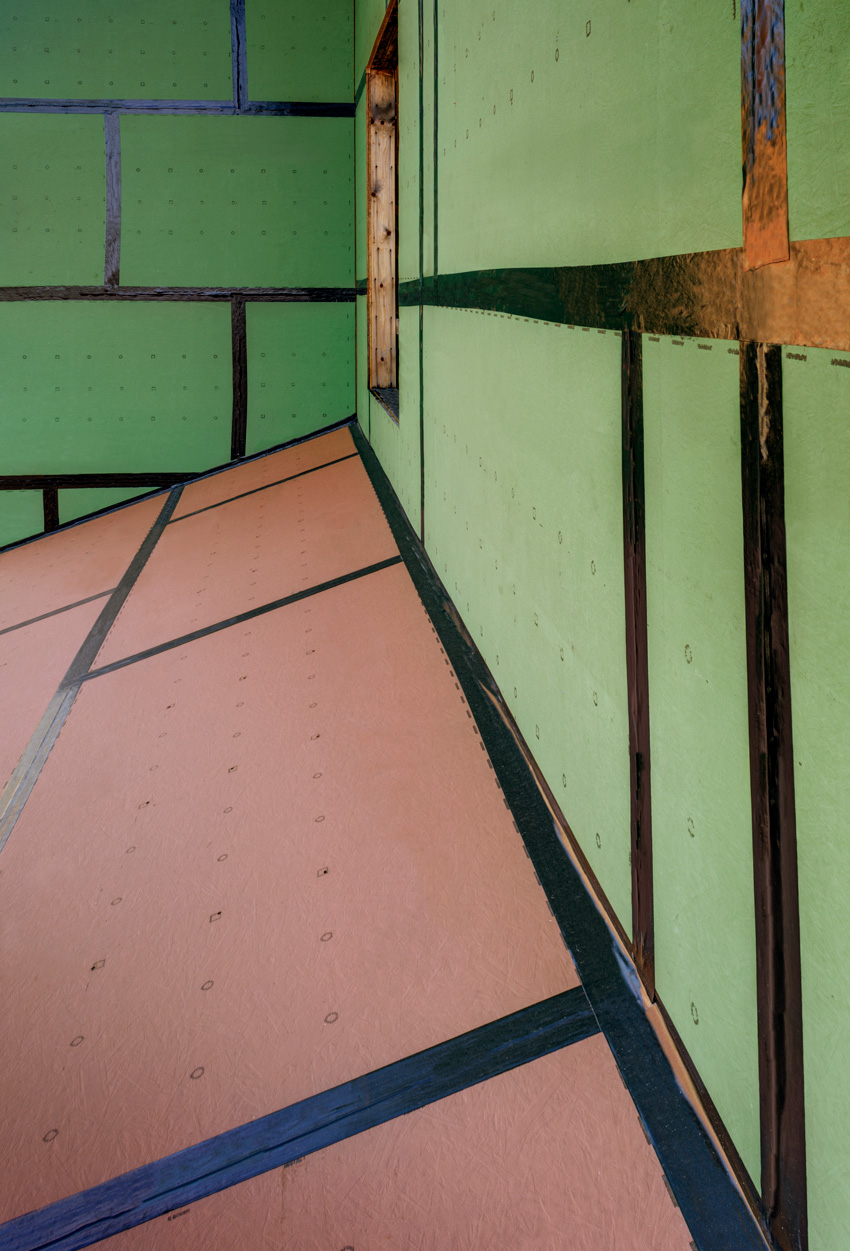
Unvented roof assemblies can be a design requirement for many different reasons. The 2018 code allows such assemblies with more options than in previous years all related to climate zone.
Assuring Barrier Continuity
We have seen the importance of paying attention to details of venting for air and moisture and how they are directly tied to the water, air, vapor, and thermal barriers in a roof system. In particular, we have looked at both vented and unvented wood-framed roofing systems, recognizing that the same fundamental forces are at play and that we just need to be sure they are dealt with appropriately in the final design and construction. We have looked at the various types of insulation that can be used and their impact on the total assembly, as well as the need for interior vapor retarders and air barriers to keep moisture out of the places it doesn’t belong. Let’s focus now on the choices for the exterior water and air barrier which are critical in all scenarios.
We have noted that in a vented attic situation, the air barrier is usually at the ceiling line to keep air infiltration from entering the conditioned space. The thermal barrier (insulation) is above that, and the ventilated space is above that, so there is no sense in putting the air barrier on the outside as is done with wall construction. However, that changes when insulation completely fills the framing space and there is no ventilation provided (i.e., unvented conditions). Then, as we saw in the code requirements, the air barrier not only needs to be on the exterior (roof sheathing) side of the assembly but it must also be fully continuous and tie into vapor-diffusion ports when applicable.
As with most design and construction details, there are choices available in how to achieve the intended results through the use of different products or materials. From a design and specification standpoint, roofing barrier options can be classified into two general categories as follows.
Conventional, Multi-Product, Multilayer Solutions
The conventional approach to achieving the needed barriers is to use a multi-product, multi-layer solution. In this case, each of the four barriers is specified and installed as a separate layer in an assembly. During design, this requires investigating and specifying multiple products that need to be compatible with each other. There also needs to be proper detailing between the materials to assure the total system will work as intended. During construction, it means performing multiple labor tasks, perhaps by different trades that need to be coordinated to assure that all of the barriers work without compromising any of the others. Further, to be assured that their installed performance will be met, the particular combination of products needs to have been tested to assure they meet all of the water, air, and thermal thresholds required for the assembly.
Integrated Product Solutions
Integrated sheathing products that can provide at least two of the needed barriers as part of an overall system for wall and roof assemblies are replacing traditional materials and methods on many projects. These products typically come in the form of engineered structural wood sheathing with preapplied coatings that qualify as both a water-resistant barrier and an air barrier. This means that a single high-performing wood sheathing product can be specified, used as the basis of design, and installed by a single trade in the building. Such integrated sheathing systems rely on factory-created sheathing surfaces that are tested to achieve both air- and water-barrier standards with a higher assurance of performance since they are installed under controlled conditions. In some cases, they can also include a thermal barrier of air-impermeable continuous insulation of differing thickness preapplied to the sheathing and ready to install. Overall, design and installation can be simpler and quicker to detail and install, reducing the amount of labor and skill needed in the field to create an effective, high-performance end result.
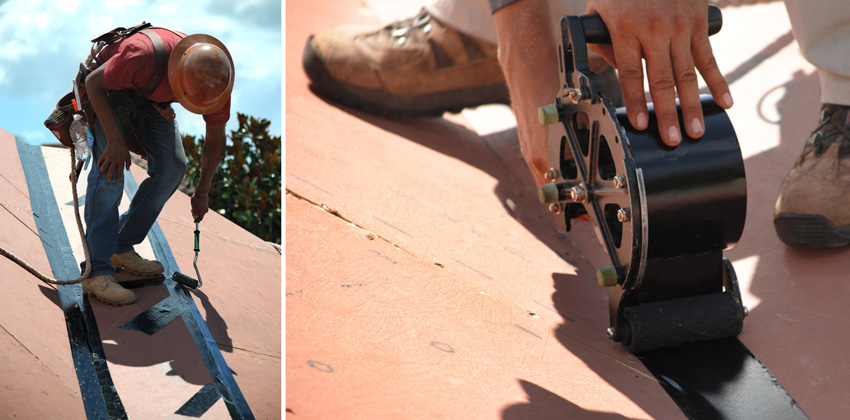
Continuity of the air barrier across a roof is important in all cases but especially those where vapor ports are used. Integrated sheathing with tape designed for addressing seams and transitions is a simplified product solution to meet this need.
Of course, such integrated sheathing products need to address the joints, penetrations, and openings just like any other system to assure continuity and effectiveness. In this case, that is achieved with self-adhering tape, sealants, and even liquid flashing that are part of the same overall system. The beauty of these components is that they are already determined by the manufacturer to be directly compatible with the sheathing, which is critical since noncompatible components could separate and fail over time, causing significant breaches in the barriers. The flexible characteristics of the tape and liquid flashing also allow for a lot of versatility to accommodate design variations or differing site conditions. They can conform completely to the shape of the substrate surface to seal and protect the surrounding construction in a truly continuous manner by covering the joints and seams between the pieces of sheathing. This allows for the needed structural gapping in the sheathing but assures that the air and water barrier is fully continuous even with minor expansion and contraction of the sheathing panels. Penetrations can be treated in the same manner with the self-adhering tape covering the entire perimeter of the hole or opening and wrapping the edge of the sheathing. Once the reason for the penetration is installed (i.e., pipe, duct, wire, etc.), a compatible sealant should be used to fill in completely any remaining gaps.
As a fully integrated system, manufacturers have been able to subject the whole system to standardized testing to demonstrate performance and code compliance. For example, the International Code Council has a subsidiary that evaluates different submitted products and produces ICC-ES Evaluation Reports documenting its findings. In the case of integrated sheathing products, ESR-1473 documents the tested sheathing and tape as being in compliance as a PS-2 wood structural panel, roofing felt, and underlayment all in one product. In ESR-1474, it also reports on the ability of the system to act successfully as an air barrier.
Overall, this type of multifunctional, integrated single-panel system streamlines wood-framed roof construction by providing a water barrier, air barrier, and structural roof deck all in a single product. That saves time and money compared to multiple layers of individually installed products like sheathing plus peel-and-stick or other field-applied barriers. Reducing the layers of product installation in this manner lowers the risk profile for design and construction professionals by reducing installation steps and the number of products used. It also helps to assure that unvented roofing designs, whether meeting the 2015 or 2018 code provisions, have a reliable way to achieve a continuous air barrier along the exterior and vapor-diffusion ports when used.
Conclusion
We have seen a range of wood-framed roofing construction options, examined the importance of the four barriers in them, and the significance of ventilation and vapor diffusion for their long-term durability. Recognizing the variables not only in roof design and construction but also in climate zone differences and perm ratings of materials, it is clearly difficult to provide single design solutions that work everywhere. That is why the codes allow for options but still expect the design professional to design the system specific to a project and its location. In so doing, Yost, Dr. Lstiburek, and others sum things up by offering some basic design guidelines that all architects can follow.1
- Ventilate attics and roofs as much as possible.
- Simple roofs are more forgiving than complex ones; avoid unnecessary complexity.
- Select materials for roof assemblies from manufacturers that provide comprehensive hygrothermal (vapor permeance) performance data.
- Choose manufacturers willing to work with you on how their materials perform in combination with all other components of the assembly. Using integrated materials means that coordination is already built in.
- Focus on continuous control layers in this order: water, air, vapor, and thermal.
- The air-control layer needs particular attention - make roofs airtight.
- Do not vent to manage air leakage; this is a losing proposition.
- Manage energy and moisture with equal intensity. It’s not just a good idea; it’s required by codes.
END NOTES
1Yost, Peter. "Avoiding Wet Roofs: A building-science guide to insulating attics and roofs". The Journal of Light Construction. June 2018. Web. 7 Nov. 2018.
Peter J. Arsenault, FAIA, NCARB, LEED AP, is a nationally known architect, consultant, continuing education presenter, and prolific author advancing building performance through better design.
www.pjaarch.com, www.linkedin.com/in/pjaarch



 All images courtesy of Huber Engineered Woods © 2018
All images courtesy of Huber Engineered Woods © 2018






